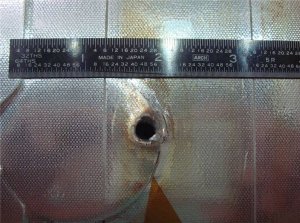

If it weren’t enough to knowingly sit atop a rocket, travel through an invisible barrier that’s so hot, it could incinerate you within seconds, and face the possibility of becoming trapped in the black abyss of space with no way home— there are numerous other little-known dangers that astronauts face.
Indeed, heading to space is no easy feat. About a dozen individuals who dared to go where no man (or woman) has ever gone before have paid for the honor with their lives — including the most well-known incidents, the Challenger and Columbia disasters.
Here are three things you might want to consider if you ever get to see our planet from more than 300 kilometers above the ground.

Space Junk:
The thermosphere, the layer of the Earth’s atmosphere located between 85 and 600 kilometers above the ground, is full of all sorts of waste. There are estimated 300 million pieces ‘space junk’ — like screws, rocket and satellites elements, as well as other elements — surrounding Earth. The average speed of each part is about 10 kilometers per second (36,000 km/h) and even the slightest contact could be catastrophic to us and our technologies.
The movie “Gravity” does a great job focusing on how harrowing this scenario must be. Luckily, there are special radar systems in place that keep track of each and every large piece of debris, as the risk of a collision is too high to NOT do so.
Oxygen (Or The Lack Thereof):
As everyone should know, there is no air in space, and there certainly isn’t any oxygen to breathe. As such, while working outside of the iSS, each astronaut carries a container with 7 to 8 hours of oxygen. That may seem like a lot, and it is more than enough most of the time, but under certain circumstances (times when an astronaut panics, or has an elevated heart rate), the levels tend to drop very fast.
NASA also has prepared a lot of procedures to avoid any situation in which the astronaut will be left alone in space.
First of all, each time an astronaut ventures into space, they must be anchored to a vehicle with a durable cable. What is more, the astronaut owns special rescue machine called SAFER – special jet pack. After losing a connection with the shuttle, SAFER starts automatic sequence of nozzle activation in order to transport the astronaut back to space vehicle. But what if the distance is too big to overbear it with about 1,5 kilograms of fuel? Then the person is condemned to death—because in the vacuum of space no movement, except from jet one, is effective.
Acrophobia:
Some people who are afraid of heights suffer from fear when faced with the distance of just a few meters. What about 350 kilometers? It’s the distance on which average space missions take place. Not only are astronauts far away from planet’s surface, they also move at speeds reaching 30,000 kilometers per hour! Due to great expanses, the velocity is not felt in the same way as it is felt on Earth, but still poses great danger.
The acrophobic fear seems understandable. After all, as previously indicated, if someone made a mistake and somehow lost connection with the ship, it would take few revolutions around the Earth before dying due to oxygen shortage. After that, the person’s body would slowly descend toward the surface, which can last a few years, and after that the corpse would burn up in the atmosphere.
It’s no wonder that being an astronaut is connected with years of training, detailed and conscientious protocols, and many personal tests.
__________________
This article was written by Mateusz Radziwonowicz.